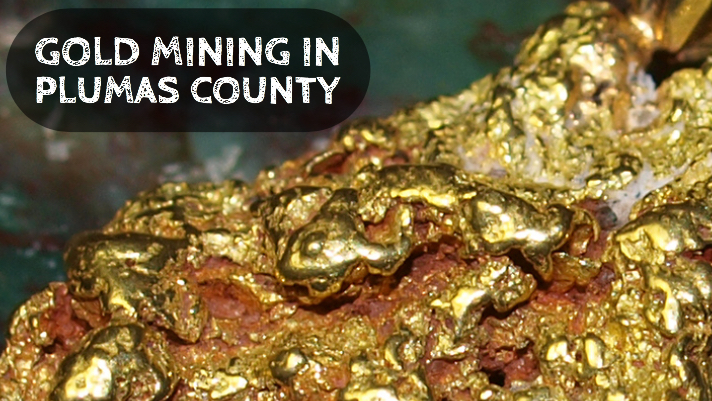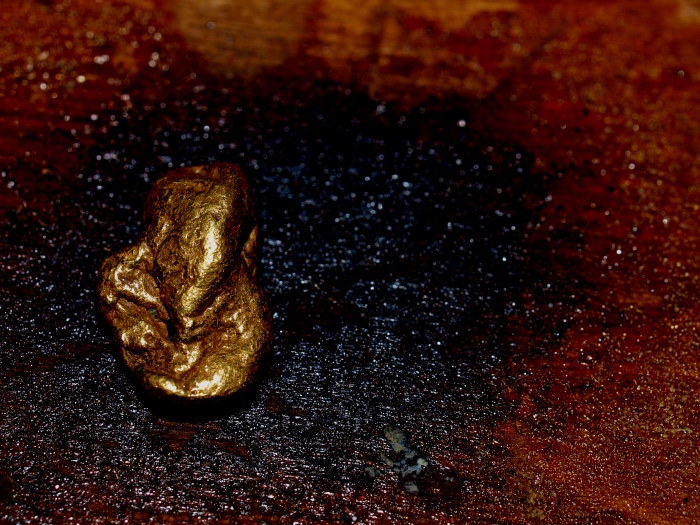
Plumas County covers an the far northern extent of the Sierra Nevada Mountain Range, and includes several very rich gold deposits. This area was being mined not long after the initial discovery of gold in California. Within a few short years, major mining operations were in place.
There are many large hard rock mines throughout Plumas County, but most of the production from this area has come from the placers. The Feather River is the major drainage that flows through the county, but there are also some “ancient” river channels, also called Tertiary rivers, that were the primary gold producers.
Tertiary Gold-Bearing River Channels
The rich gold deposits contained within ancient river channels can be found throughout the California Mother Lode, and Plumas County is no exception. These are old river channels that have basically become “high and dry” under natural geological conditions. For whatever reason of the past millions of years the flow of these rivers changed.
When the river changes direction the old channel was abandoned for a new route. What you are left with is a gold-rich river without a drop of water. Then over the course of millions of years, geologic lifting occurred, causing these ancient channels to raise up. The result is ancient placer deposits that are well above the existing river.
Hydraulic Mining
Without water it was a challenge to effectively mine these ancient channels. The solution was to use the method of hydraulic mining. Ditches and flumes were constructed to bring in water from long distances, which were then routes through hoses and large cannons.
Miners literally washed away the hillsides with high pressured water, releasing the gold-bearing gravels. It could then be run through sluice boxes and the trapped gold could be recovered.
These early hydraulic mines accounted for most of the gold that has been found in Plumas County.
La Porte District
There was no bigger mine in Plumas County than the hydraulic pits that operated in the La Porte Mining District. The gravels being mined here were from a channel of the Yuba River, many millions of years old.
The huge mines at La Porte were responsible for an estimated 3 million ounces of gold during the first few decades operation! This accounted for nearly $60 million in gold (nearly $4 billion at todays gold price!)
This was by far the biggest producer in Plumas County until debris control laws were enacted to prevent erosion on farmlands caused by hydraulic mining. After the hydraulic mining ceased, drift mining was done on a much smaller scale. Gold continued to be recovered but nowhere near as much as from the hydraulic mines.
Also Read: The Use of Hydraulic Mining in Gold Country
And: You Can Still Find Gold at Old Hydraulic Mining Sites
Crescent Mills District
This is primarily a hard rock mining district. The richest lodes were mined at the Green Mountain Mine with an estimated $1 to $2 million in gold being extracted from the ores. Most of the mining here occurred prior to 1890, with some periodic activity up through the 1950s. This activity accounted for perhaps 100,000 more ounces.
Placers in the area were worked sporadically by small-scale miners. Production information is limited. The gold occurrences in the area are well-known but were not rich enough to warrant large operations like those in the La Porte District.
Johnsonville District
The Plumas Eureka Mine was the largest lode mine in the county. Most mining here occurred from the 1850s to the 1920s, with only limited mining after that.
Total estimated recovery from the mine was around $8 million dollars, with perhaps another $1 to $2 million mined from the sporadic activity that took place u through the 1950s.
IN 1890, a new mine called the Jamison Mine was established. It was much smaller that the Plumas Eureka Mine, but it continued to produce profitable ores after the closure of the Plumas Eureka.
Most of the Johnsonville district is now within the Plumas Eureka State Park. The mine and mill are actually quite well preserved and this is a very interesting place to visit. An old boarding house has been converted to a mining museum that pays tribute to the early history of the region.
The park offers limited gold panning opportunities on Jamison Creek, but larger equipment is not allowed. In general this is a very popular place to visit but gets less pressure than many other State Parks in California.

Prospecting Areas in Plumas County
These historic mining areas should give you a few ideas about where to explore if you decide to do some prospecting in the area. There is still lots of gold in this part of California. Remember than many of the mines shut down for a variety of reasons aside from simply “running out of gold.”
There are many old hydraulic pits throughout Plumas County. These operations were shut down due to erosion concerns, but they still have plenty of gold. In fact, many prospectors successfully use metal detectors in these old hydraulic pits to find gold nuggets that were missed. You can often find these areas by using Google Earth and looking for the scars left on the landscape.
The Feather River has gold all throughout it, and this is still a great place to look for gold. Many smaller creeks adjacent to the major mining districts are also worth exploring such as Jamison Creek.
Canyon Creek is a tributary to the Yuba River and is a good area to prospect. It flows along the Oroville Quincy Highway and has some decent gold in it. You can pretty much explore any of the small tributaries that flow into it and you are likely to find some decent color.
There are plenty of areas to prospect with the Plumas National Forest. There are historic mines scattered all throughout the forest that are worth exploring. I suggest bringing along a simple gold pan and sampling the drainages for color. Once you’ve determined that there is some gold in the area, bring in some larger placer equipment or even a metal detector to hunt for gold nuggets.

Wild & Scenic Feather River
Be aware that there is some very good gold mining areas that fall within an area of the Feather River that is designated as “Wild & Scenic.” These areas are frustrating for serious miners because there are heavy restrictions on using motorized equipment, and if you do find a good gold deposits you can’t file a mining claim in this area.
Despite that, I would urge you to not necessarily overlook these locations. Some areas of the Feather River are very, very rich in gold. Even with limited equipment you can recover some pretty nice gold just spending a nice day panning along the river.
Next: Good Times & Gold Mines of Sierra City, California
